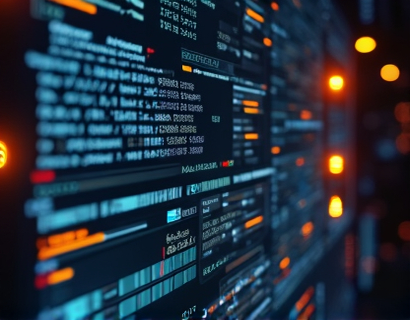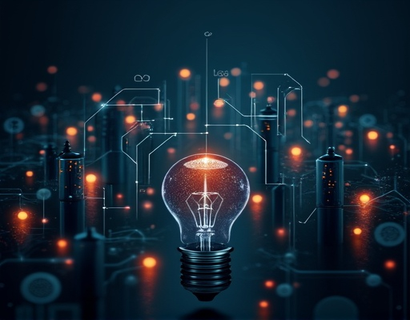The Synergy of AI and Crypto: Transforming Digital Ecosystems for Enhanced User Experiences
The intersection of artificial intelligence (AI) and cryptocurrency is ushering in a new era of digital transformation, redefining how we interact with technology and each other. This fusion is not just a technological curiosity but a powerful force driving innovation, enhancing user experiences, and fostering growth across various sectors. As we delve into this topic, it's essential to understand the foundational roles that AI and cryptocurrency play individually before exploring their synergistic impact on digital ecosystems.
Understanding AI and Cryptocurrency
Artificial intelligence, a subset of computer science, focuses on creating systems that can perform tasks requiring human intelligence, such as learning, reasoning, and self-correction. AI technologies include machine learning, natural language processing, and computer vision, each contributing to the development of smarter, more intuitive applications. On the other hand, cryptocurrency, exemplified by Bitcoin, is a digital or virtual currency that uses cryptography for security and operates on a decentralized network, typically a blockchain. This decentralized nature ensures transparency, security, and reduces the need for intermediaries.
The convergence of these two technologies is particularly significant because it leverages the strengths of both. AI's ability to process and analyze vast amounts of data can be applied to enhance the security, efficiency, and user experience of cryptocurrency systems. Conversely, the decentralized and secure nature of cryptocurrency can provide a robust framework for AI applications, ensuring data integrity and user trust.
Enhancing Security and Trust
One of the most immediate benefits of combining AI and cryptocurrency is the enhancement of security measures. Traditional systems often rely on centralized servers, making them vulnerable to hacking and data breaches. By integrating AI into cryptocurrency networks, systems can dynamically adapt to new threats, improving fraud detection and preventing unauthorized access. Machine learning algorithms can analyze patterns and identify anomalies in real-time, providing a proactive defense mechanism.
Moreover, AI can optimize the consensus mechanisms used in blockchain technology. Proof of Work (PoW), while secure, is energy-intensive. AI can help develop more efficient consensus algorithms, such as Proof of Stake (PoS) or Delegated Proof of Stake (DPoS), reducing energy consumption without compromising security. This not only makes cryptocurrency more sustainable but also more appealing to a broader audience concerned about environmental impact.
Improving User Experience
The user experience in digital ecosystems is paramount for adoption and retention. AI-driven personalization is a key factor here. By analyzing user behavior and preferences, AI can tailor content, recommendations, and services to individual needs, creating a more engaging and satisfying experience. In the context of cryptocurrency, this means more intuitive and user-friendly wallets, exchanges, and financial tools that cater to both novice and experienced users.
Natural Language Processing (NLP) is another AI technology that can significantly enhance user interaction. Chatbots and virtual assistants powered by NLP can provide 24/7 customer support, answer queries, and guide users through complex processes. This not only improves user satisfaction but also reduces the workload on human support teams, making services more efficient and cost-effective.
Optimizing Network Performance
Cryptocurrency networks, especially those using blockchain, can benefit greatly from AI in terms of performance optimization. AI algorithms can predict network congestion, optimize transaction processing times, and balance load across the network. This ensures smoother operations and faster transaction confirmations, which are critical for user trust and adoption.
Additionally, AI can enhance the scalability of blockchain networks. By analyzing usage patterns and identifying bottlenecks, AI can propose solutions to increase the network's capacity without sacrificing security. This is particularly important as the number of transactions and users grows, ensuring that the ecosystem remains robust and responsive.
Fostering Innovation and New Business Models
The integration of AI and cryptocurrency is not only about improving existing systems but also about enabling new possibilities and business models. For instance, AI can facilitate the creation of decentralized applications (dApps) that offer innovative services, from decentralized finance (DeFi) platforms to non-fungible tokens (NFTs) for digital art and collectibles. These dApps leverage AI to provide smarter, more dynamic functionalities that traditional centralized applications cannot match.
Moreover, AI can enhance the development and management of smart contracts. By analyzing and predicting potential issues in smart contract code, AI can help developers create more secure and efficient contracts. This reduces the risk of errors and vulnerabilities, increasing user confidence in these automated agreements.
Data Analytics and Insights
Data is the lifeblood of both AI and cryptocurrency. The combination of these technologies allows for advanced data analytics, providing deep insights into user behavior, market trends, and system performance. AI can process and analyze large datasets to uncover patterns and trends that would be impossible for humans to detect manually. This data-driven approach enables more informed decision-making, from product development to marketing strategies.
For cryptocurrency projects, AI-driven analytics can help in understanding market sentiment, predicting price movements, and identifying investment opportunities. This not only benefits individual investors but also helps in the overall stability and growth of the cryptocurrency ecosystem by attracting more legitimate and informed participants.
Case Studies and Real-World Applications
Several projects and platforms are already leveraging the synergy between AI and cryptocurrency to transform digital ecosystems. One notable example is Augur, a decentralized prediction market that uses AI to improve the accuracy of predictions. By combining user-generated data with AI algorithms, Augur provides more reliable and transparent outcomes, benefiting both participants and stakeholders.
Another example is the use of AI in cryptocurrency trading platforms. Platforms like Crypto.com integrate AI-driven trading bots that analyze market data in real-time, execute trades, and manage portfolios on behalf of users. This not only democratizes access to professional trading strategies but also enhances the overall trading experience through automation and intelligence.
Challenges and Considerations
While the potential of AI and cryptocurrency is vast, there are challenges that need to be addressed. One major concern is regulatory compliance. The decentralized nature of cryptocurrency and the complex algorithms of AI can complicate adherence to existing regulations. It's crucial for developers and businesses to stay informed about legal requirements and work towards creating compliant solutions.
Another challenge is the technical complexity involved in integrating AI with cryptocurrency systems. Developing robust, secure, and scalable solutions requires expertise in both domains. Collaboration between AI researchers, blockchain developers, and cybersecurity experts is essential to overcome these technical hurdles.
Future Outlook
Looking ahead, the fusion of AI and cryptocurrency is poised to drive significant advancements in digital ecosystems. As AI technologies continue to evolve, we can expect even more sophisticated applications, from enhanced privacy solutions to more intuitive user interfaces. The decentralized and transparent nature of blockchain, combined with the intelligence of AI, will likely lead to the creation of more resilient and user-centric digital environments.
Moreover, the growing adoption of 5G and the Internet of Things (IoT) will further amplify the impact of AI and cryptocurrency. Faster connectivity and increased device interoperability will enable more seamless integration of these technologies, opening up new possibilities in areas such as smart cities, healthcare, and beyond.
In conclusion, the synergy between AI and cryptocurrency is not just a technological trend but a transformative force reshaping the digital landscape. By enhancing security, improving user experiences, optimizing network performance, fostering innovation, and providing valuable insights, this fusion is paving the way for a more intelligent, secure, and engaging digital future. Tech innovators and early adopters who embrace these technologies will be well-positioned to lead and thrive in this evolving ecosystem.










































